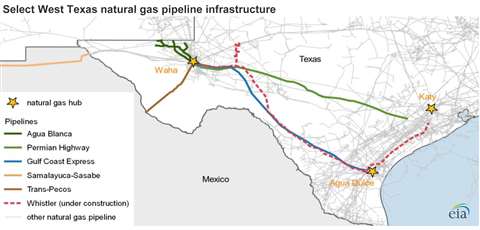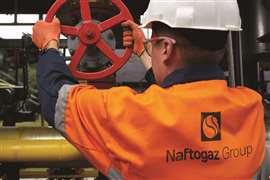U.S. gas pipeline exports to Mexico slide 4%
August 18, 2022
 Natural gas pipeline exports from West Texas averaged 1.6 Bcf/d in May 2022, the highest on record. (Map: EIA.)
Natural gas pipeline exports from West Texas averaged 1.6 Bcf/d in May 2022, the highest on record. (Map: EIA.)
Total pipeline gas exports from the U.S. to Mexico have fallen 4% to 5.7 Bcf/d in the first five months of the year when compared with the same period a year ago, according to statistics from Wood Mackenzie.
As total U.S. exports have fallen, exports from West Texas have climbed while exports from South Texas, Arizona and California have fallen in the same period. Exports from South Texas fell 5% to average 3.8 Bcf/d while combined e xports from California and Arizona fell 24% to average 0.5 Bcf/d.
Natural gas pipeline exports from West Texas averaged 1.6 Bcf/d in May 2022, the highest on record. Compared with 2021, U.S. pipeline exports from West Texas increased by 12% from January through May 2022 to average 1.4 Bcf/d.
U.S. natural gas pipeline exports from West Texas have grown steadily in recent years, doubling from 0.6 Bcf/d in 2019 to 1.2 Bcf/d in 2021 as more connecting pipelines in Central and Southwest Mexico have come into service over the last three years.
Since October 2020, two completed projects in Texas and two others in Mexico have boosted the access from the Waha hub in West Texas to demand markets in Mexico and have reduced the spread between natural gas at Waha and Henry Hub.
Natural gas flows from the Permian natural gas production areas in West Texas to Northwest, Central, and Southwest Mexico via the Chihuahua-to-Bajío corridor (including the Samalayuca-Sásabe pipeline system) and the Wahalajara system. So far this year, exports from West Texas on the Samalayuca-Sásabe system have increased and displaced some U.S. pipeline exports from Arizona.
The Samalayuca-Sasabe pipeline system stretches 629 km from the near Ciudad Juarez (near El Paso, Texas) and ends in Northwest Mexico near the town of Pitiquito, Mexico. It started operations in 2021 and transports up to 889 MMcf/d.
The Wahalajara system is a group of new pipelines that connects the Waha hub in West Texas to Guadalajara and other regions in west-central Mexico. Since 2016, Mexico has steadily expanded its natural gas pipeline system, which has boosted exports from the U.S.
In Mexico, steady demand for gas from power producers and the industrial sector have led to growth in consumption in Mexico in recent years. A large part of this growth has come from pipeline imports from the U.S.
The availability of relatively inexpensive natural gas from the United States has shifted Mexico’s natural gas supply mix. The share of Mexico’s natural gas supply met by pipeline imports from the United States grew from 61% in 2019 to 72% in 2021, but it has declined to 69% in the first seven months of this year as a result of rising U.S. natural gas spot prices, according to a study from Wood Mackenzie.
Mexico increased its domestic natural gas production by 15% during the first seven months of 2022 compared with the same period in 2021. The recent increase in Mexico’s domestic production was driven primarily by the Quesqui and Ixachi production fields, which produce a higher proportion of dry natural gas. Recent improvements in drilling rigs’ operating efficiency have also contributed to rising natural gas production.
In addition to the decline in pipeline imports, liquefied natural gas imports have fallen from over 7% of total supply in 2019 to less than 1% so far in 2022.
MAGAZINE
NEWSLETTER

CONNECT WITH THE TEAM








